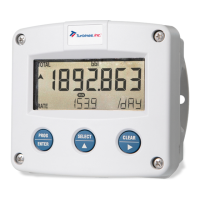Page 35
FW-F103-P-XN-M_v2002_03_EN.docx
Metal enclosure
When the F103-P is supplied with a metal enclosure (aluminum or stainless steel), the enclosure
must be grounded in accordance with national and local electrical codes.
To ground the F103-P, the PE conductor must be connected to the PE stud which is located in the
metal back panel, as indicated in the image below. To connect the conductor, a screw (M4 x 6mm)
with a serrated washer, a terminal and a washer is used (torque: 2 Nm). The metal front panel is
connected to the Protective Earth by the mounting screws with serrated washers.
Fig. 22: Protective Earth (PE) connection on metal enclosure
Metal enclosure with conduit hubs
When the F103-P is supplied with a metal enclosure (aluminum or stainless steel) and installed with
conduit hubs, the conduit hubs are automatically grounded by the threaded connection with the
metal enclosure. Make sure to order the F103-P with the correct drilling pattern and thread sizes.
Plastic enclosure
When the F103-P is supplied with a non-metal enclosure (e.g. plastic), the enclosure meets the
requirements of class 2 (double insulated). Therefore any incoming PE conductor can be terminated
with an insulating end cap.
Plastic enclosure with conduit hubs
When the F103-P is supplied with a non-metal enclosure (e.g. plastic) and installed with conduit
hubs, the conduit hubs need to be grounded in accordance with national and local electrical codes.
For this purpose, a metal grounding plate is inserted in the back panel into which the hubs are
secured and the PE conductor must be connected, as indicated in the image below. To connect the
conductor, a screw (M5 x 8mm) with a serrated washer, a terminal and a washer is used (torque:
2 Nm).
Fig. 23: Protective Earth (PE) connection on conduit hub grounding plate

